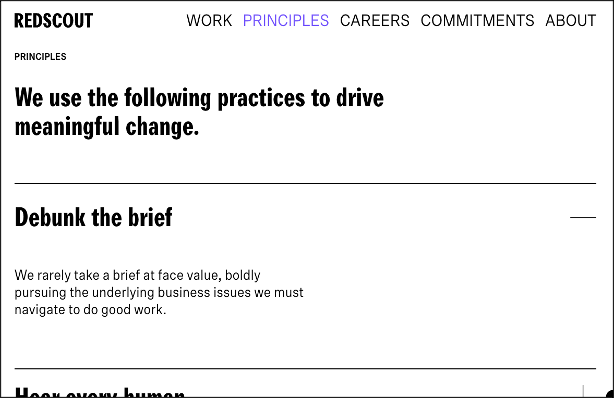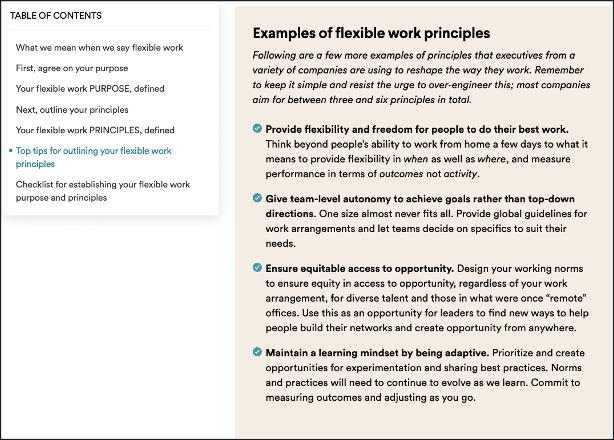This article is part of a series about designing a high-performing marketing organization.
Organizations thoughtfully designed to run lean, easily adapt to changing priorities, and produce remarkable work at the speed of modern marketing, have an advantage over others.
They have clear, actionable rules of engagement for how they will and won’t operate.
They’ve channeled these rules into a written set of operating principles to guide their people and business affairs and benefit tremendously. You may think your firm or agency has what I’m describing, but I’ve observed that most do not. Read on for examples and a way to put your organization to the test.
What do we mean by ‘operating principles’?
Operating principles create a shared internal mindset for how teams think, act and make decisions about their daily work. They are critical for alignment and smooth scalability. While “principles” is often used interchangeably with “values,” there’s a significant difference.
What are values?
Company values define your culture. Firms and agencies typically present their values as a list of qualities or phrases that reflect how their people treat each other.
Here are some examples that I’ve pulled from a variety of creative marketing firms:
- Integrity, accountability, listening, simplifying, persevering, collaborating.
- “Create amazing work,” “Be honest,” “Share your voice,” “Be bold and brave,” “Deliver value.”
It’s helpful for an organization to communicate how they believe people should interact with each other. However, the average list of values is not actionable, memorable or even differentiating. Principles intentionally differ.
What are principles?
Principles reflect your organization’s philosophies and beliefs about how your firm or agency should and should not operate. They are the line in the sand defining the things you will always do and those you will never do.
Principles should not prescribe — they are not a “how to” instruction manual, leaving room for autonomy. But they should be actionable enough to guide how people think, act and make daily business decisions.
As an example, if we took the value “be honest” from the values above and wrote it as a principle, we might say:
- Tell the truth no matter what the cost.
As a written, defined principle, it draws a line in the sand. I’ll share more examples and a way to test the strength of your own organization’s principles in a moment.
Competitive advantages from operating principles
You can gain many advantages from using a principles-based approach to leading your marketing organization.
- New team members can rely on your principles to guide their decisions.
- You’ll have consistency in the way people approach their daily work.
- You’ll reduce the need for managerial oversight and prescriptive direction.
- You’ll be able to scale more smoothly without negatively impacting speed or quality.
- They differentiate your firm or agency and generate a competitive advantage.
Principles are critical for alignment and smooth scalability.
“If you focus on principles, you empower everyone who understands those principles to act without constant monitoring or controlling.”
– Stephen R. Covey
In addition, when a creative marketing firm or in-house agency has strong operating principles about the quality of their work, their teams know when to push back on a client’s request if it conflicts with their principles.
To the team, being accountable to their principles is more important than being accountable to their clients. As a result, they are more comfortable saying no to unreasonable budgets or deadlines or uninformed requests from stakeholders to change their creative direction.
Relevant examples of operating principles
Here are some operating principles from creative marketing firms and other organizations.
TBWA
Referring to themselves as the “Disruption company,” TBWA’s principles help them “achieve the diverse, inclusive lens in our work and create real-world impact.”
They state that their principles are the “standards we measure ourselves against; the standards we hold each other accountable to; the standards getting us where we want to go.”

Massive Change Network
This global design consultancy takes a different approach. They live by “The Incomplete Manifesto for Growth,” a list of 43 principles with explanations of each.

RedScout
The brand innovation consultancy, RedScout, lists five principles they use to drive meaningful change.

37signals
37signals, the makers of Basecamp and Hey, share their principles to guide internal communication.

Future Forum
Future Forum is a consortium focused on helping organizations build flexible, inclusive and connected ways of working. They have collected samples of principles being used across various companies to reshape how those companies work — specifically, to develop their flexible work models.

How to define a set of principles
Since your principles will guide how your creative marketing firm or in-house agency operates, you should take a strategic approach to draft them. Consider the following questions:
- What type of service experience do your clients expect from you?
- What do your current and prospective employees expect from you?
- How do technology and digital channels impact your work and your target market?
1. Define principles that help you meet the expectations of your clients
Over the past several years, client-side brand and marketing leaders have increasingly evaluated creative marketing firms based on criteria beyond capabilities and creativity. Client-side marketers are becoming more focused on how creative and marketing firms operate, per the 2018-2019 Global Digital Outlook Study by the Society of Digital Agencies (SoDA) in partnership with Forrester Research. They want partners who can deliver with greater speed, nimbleness and value.
- Speed of delivery had become a significant factor in whether or not creative marketing firms won new projects.
- A “more flexible and nimble working model” was cited as a top area of improvement that marketing clients wanted to see from their creative marketing partners.
- And “price vs. value” was cited as the top reason clients terminate a partner relationship. They wanted greater value from their agencies.
I’ve seen similar data reported in other industry research and regularly hear similar stories firsthand in my consulting work with creative marketing firms. Some have also shared that they’ve lost clients due to delivery speed. For them, it has become normal to receive RFPs and RFIs from client-side marketers with questions about their firm’s process, turnaround times and how they collaborate.
Whether you’re a creative marketing firm or an in-house agency, consider how you can draft your principles to help you meet your client’s demand for speed, nimbleness and value.
2. Define principles that help you meet the expectations of your creative talent
Many years before the pandemic, there was already a lot of talk about the “future of work.” Businesses applied the principles and frameworks of different future work movements to redesign their organizations.
Some examples of the movements and frameworks that have been reshaping how companies work are:
The pandemic accelerated the adoption of many values behind these movements and some of their practices. But, if you were to study these movements, you’d learn they are largely about giving people what they need to deliver great work.
Some of the shared values behind these movements are:
- Trust.
- Transparency.
- Autonomy.
- Adaptability.
- Co-creation.
- Continuous improvement.
- Work-life balance.
An increasing number of companies are making significant changes to apply these values and create work environments that appeal to your talent pool. Can you afford not to do the same?
When drafting your principles, consider how they can help you align your firm or agency with these values.
3. Define principles that help you adopt technology for a competitive advantage
Most marketing organizations focus on digital and online marketing channels, but many haven’t adapted to keep up with the variety, volume or velocity of content needed. Instead, they’ve continued business as usual or slightly adjusted their operating model. As a result, they’ve been building up what Steve Blank called organizational debt.
Organizational debt happens when a business grows but doesn’t invest the necessary time and energy toward adapting how it operates to keep it running smoothly. The firm or agency is too focused on just getting work done. Then, one day, they step back and realize they have a set of performance challenges.
When drafting your principles, consider how they could help you take full advantage of existing and emerging technology.
4. Define principles to clarify what you will and won’t do
I’ll leave you with two last questions to answer as you consider drafting operating principles for your creative marketing firm or in-house team.
- What will you always do to create remarkable work?
- What will you never do to create remarkable work?
Remember, a well-drafted principle will draw a clear line in the sand, defining the things you will always do and the things you will never do.
How to test if you have clear, actionable principles
Here’s how you can put your creative marketing firm or in-house agency to the test. Whether you’re drafting principles for the first time or they already exist, evaluate them against the following questions.
- Are they actionable?
- Will they help someone make a decision?
- Can you logically argue their opposite?
- Are they differentiating?
- Are they polarizing?
- Do they create a competitive advantage?
- Will you stick to them even if it comes at a cost or disadvantage?
The more you can give the right answers to these questions, the stronger the principle.
To further make the point, Bill Bernback, one of advertising’s greats and co-founder of the highly-ranked worldwide advertising firm DDB, famously said, “A principle isn’t a principle until it costs you something.”
Wrapping up
Operating principles are a tremendous tool for creative marketing firms and agencies. I’ve seen their power firsthand in my work. However, the work doesn’t stop with drafting them. You’ll need to ensure everyone in your organization understands them and knows when to rely on them for guidance. Perhaps that’s a good topic for a future article.
The post How to define your marketing organization’s rules of engagement appeared first on MarTech.

0 Comments